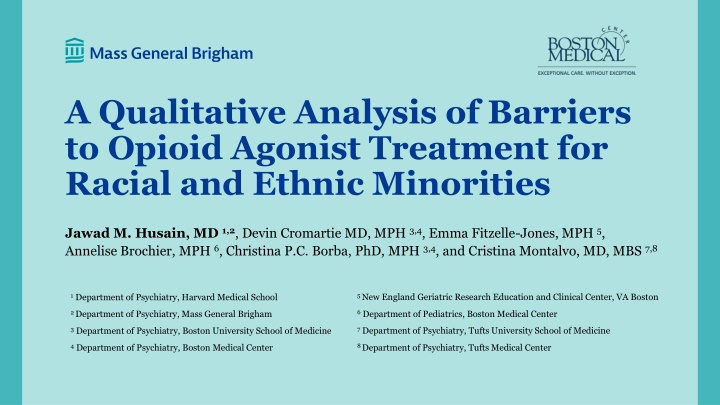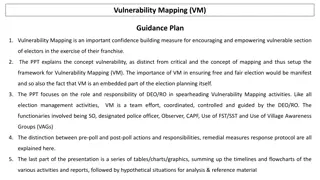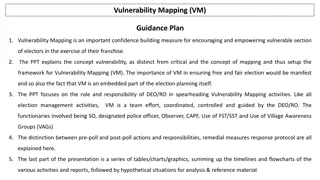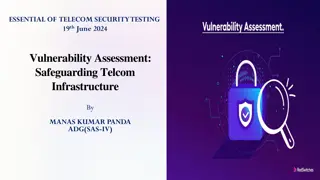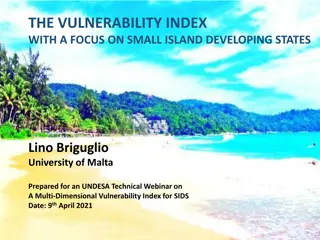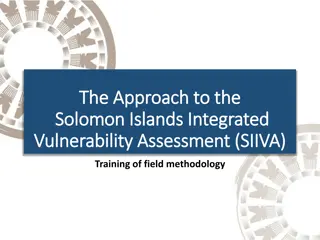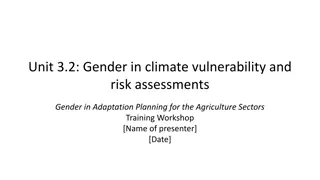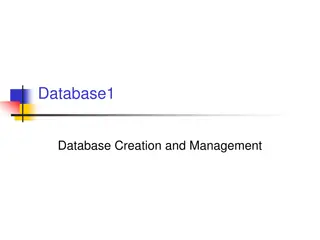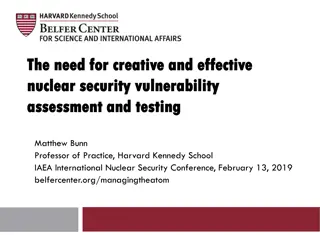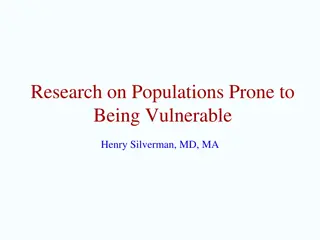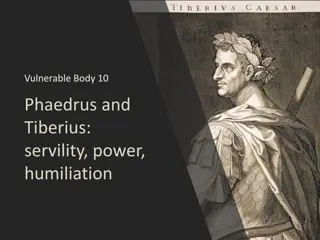Database Assessment Vulnerability Assessment Course
This course focuses on database security, covering topics such as database management systems, relational database management systems, technology breadth, and considerations for performing tests on live production systems. It discusses the importance of protecting systems and data from unauthorized access, updates, and more through various languages and engine functionalities. The agenda includes configuration guidance, operating system settings, database installation, and identification/authentication methods. Learn about the importance of non-destructive testing, penetration testing, and different product features unique to databases like Oracle, SQL Server, MySQL, and more.
Download Presentation

Please find below an Image/Link to download the presentation.
The content on the website is provided AS IS for your information and personal use only. It may not be sold, licensed, or shared on other websites without obtaining consent from the author.If you encounter any issues during the download, it is possible that the publisher has removed the file from their server.
You are allowed to download the files provided on this website for personal or commercial use, subject to the condition that they are used lawfully. All files are the property of their respective owners.
The content on the website is provided AS IS for your information and personal use only. It may not be sold, licensed, or shared on other websites without obtaining consent from the author.
E N D
Presentation Transcript
A Qualitative Analysis of Barriers to Opioid Agonist Treatment for Racial and Ethnic Minorities Jawad M. Husain, MD 1,2, Devin Cromartie MD, MPH 3,4, Emma Fitzelle-Jones, MPH 5, Annelise Brochier, MPH 6, Christina P.C. Borba, PhD, MPH 3,4, and Cristina Montalvo, MD, MBS 7,8 5 New England Geriatric Research Education and Clinical Center, VA Boston 1 Department of Psychiatry, Harvard Medical School 6 Department of Pediatrics, Boston Medical Center 2 Department of Psychiatry, Mass General Brigham 7 Department of Psychiatry, Tufts University School of Medicine 3 Department of Psychiatry, Boston University School of Medicine 8 Department of Psychiatry, Tufts Medical Center 4 Department of Psychiatry, Boston Medical Center
Disclosures The authors declare no potential conflicts of interest. 2
BACKGROUND OBJECTIVES METHODS RESULTS DISCUSSION & FUTURE DIRECTIONS
Background Increase in synthetic* opioid overdose deaths per 100,000 people, by ethnicity, 2013-20171 Opioid overdose mortality is rising fastest in the non-Hispanic Black population1,2 Racial/ethnic minorities are less likely to receive opioid agonist treatment (OAT) - especially buprenorphine3 9 4 *excluding methadone
BACKGROUND OBJECTIVES METHODS RESULTS DISCUSSION & FUTURE DIRECTIONS
Study objectives 1) Evaluate knowledge and perceptions regarding opioid agonist treatment (OAT) in a racially and ethnically diverse sample of patients with opioid use disorder (OUD) who are not on OAT. 2) Identify differences in barriers to OAT across racial/ethnic groups at the individual, interpersonal, community, and societal levels. 3) Hypothesize the relationships between racial, ethnic, and cultural identities, as well as structural factors, and attitudes towards OAT. 6
BACKGROUND OBJECTIVES METHODS RESULTS DISCUSSION & FUTURE DIRECTIONS
Participants 41 adults with opioid use disorder (OUD), not on OAT Recruited from Boston area via clinical data warehouse request, flyers, and online ads, between Sept 2020 and Feb 2021 8
Data collection Interview guide based on literature review of race disparities in OAT 1 author conducted semi-structured interviews by telephone Interviews audio-recorded and transcribed verbatim 9
Data analysis Interview transcriptsanalyzed using NVivo 12 Pro by 3 authors Developed codebook through author consensus based on review of themes in initial transcripts Coding and analysis performed according to principles of grounded theory and thematic analysis, stratified by race/ethnicity 10
BACKGROUND OBJECTIVES METHODS RESULTS DISCUSSION & FUTURE DIRECTIONS
Demographics Total (n=41) Asian (n=1) Non- Hispanic Black (n=24) 54.2 (9.6) Hispanic (n=3) Non- Hispanic White (n=9) 53.2 (10.1) More than one race (n=4) Age, mean (SD) Sex, n (%) 53.2 (10.9) 31 55.7 (7.5) 52.2 (10.8) Female Male 27 (65.9) 13 (31.7) 1 (2.4) 0 0 18 (75.0) 6 (14.6) 0 (0) 2 (66.7) 1 (33.3) 0 4 (44.4) 5 (55.6) 0 3 (75.0) 1 (25.0) 0 Nonbinary/Other Prior OAT*, n (%) Buprenorphine Methadone Currently using opioids, n (%) 1 (100) 14 (34.1) 15 (36.6) 1 (100) 0 4 (9.8) 8 (19.5) 0 7 (77.8) 6 (66.7) 2 (50.0) 0 1 (33.3) 7 (17.1) 0 7 (17.1) 0 0 0 12 *OAT = opioid agonist treatment
Interrater reliability Kappa=0.95 Agreement=98.5% 13
Themes, by race/ethnicity Racial/ethnic minority Strong negative opinions and distrust of OAT Non-Hispanic White Mixed opinions of OAT Perception of OAT Facilitators to addiction treatment Social support Self-motivation Barriers to addiction treatment Internalized stigma toward people on OAT Anticipated stigma for OAT from family or community Preferred treatment for OUD Cold turkey or residential treatment Naltrexone or cold turkey 14
Perception of OAT: Strong negative opinions and distrust of OAT [Suboxone] ain't doing nothing but making them more addicted to opiates... Only one that they really talk to is their primary care doctor and the first thing the doctors want to prescribe is some opiates. Racial/ethnic minority participant 15
Perception of OAT: Mixed opinions of OAT I'm very torn on this subject. I think that I have seen [OAT] be a wonderful resource to people getting sober and I've seen it save lives. I just think it's very important that it's a short-term plan that people get on and then they're weaned off. I've seen people stay addicted to those drugs and end up with a new ball and chain with their MAT. It keeps people sick, it keeps people around those kind of people. Non-Hispanic White participant 16
Facilitators to addiction treatment: Social support I developed friendships with people that were going through the same thing. And that kind of helped me there, developing a bond with people like me. Racial/ethnic minority participant 17
Facilitators to addiction treatment: Self-motivation No, I never did any inpatient or outpatient programs, I was just drawing upon my strength and will to quit. Non-Hispanic White participant 18
Barriers to addiction treatment: Internalized stigma towards people on OAT I have a lot of associates that are also addicts and they're also using Suboxone to help them with the using and to curb their craving. And it's supposed to help them. I've never taken a Suboxone. So I couldn't give you too much information, but it's from my observation, the people that were around me take Suboxones to curb the usage of [opioids]... but it's still the same effect to me. Looks like they're still high. Racial/ethnic minority participant 19
Barriers to addiction treatment: Anticipated stigma from family or community I was like a pariah. You know? They treated me worse on Suboxone, which is used to treat my addiction and to help me stay off of drugs... They treated me worse when I was on that than when they knew I was sniffing heroin. Non-Hispanic White participant 20
Preferred treatment for OUD: Cold turkey or residential treatment I always went cold turkey If I went to jail or just went in the program. Racial/ethnic minority participant 21
Preferred treatment for OUD: Naltrexone or cold turkey I'm a believer in Vivitrol, you don't get sick from the Vivitrol. Non-Hispanic White participant 22
BACKGROUND OBJECTIVES METHODS RESULTS DISCUSSION & FUTURE DIRECTIONS
Discussion From a structurally competent lens, we see racial/ethnic minority patients distrust of medication for OUD (MOUD) as a reaction to historical racial abuse, neglect, and stigmatization by healthcare institutions. Racial/ethnic minority patients preference for residential treatment suggests a desire for psychosocial and peer-recovery based care, addressing social determinants of health (e.g., lack of social support). 24
Limitations Single-region recruitment Unbalanced race/ethnicity and gender categories Many participants in remission from OUD 25
Future directions An approach rooted in structural humility should consider limitations of medication management-only OUD care in racial/ethnic minority populations. Addiction specialists may engage these populations better with culturally-tailored interventions for OUD that offer psychosocial treatment in combination with MOUD. 26
Acknowledgments This study was funded through grants from: APA/SAMHSA Minority Fellowship Program Gennaro Acampora Charitable Trust Fund 27
Questions? jhusain@mgh.harvard.edu @JawadHusainMD
References 1. Spencer MR, Warner M, Bastian BA, Trinidad JP, Hedegaard H. Drug Overdose Deaths Involving Fentanyl, 2011-2016. National Vital Statistics Reports. 2019;68(3):19. 2. Scholl L. Drug and opioid-involved overdose deaths United States, 2013 2017. MMWR Morb Mortal Wkly Rep. 2019;67. doi:10.15585/mmwr.mm6751521e1 3. Manhapra A, Petrakis I, Rosenheck R. Three-year retention in buprenorphine treatment for opioid use disorder nationally in the Veterans Health Administration: 3-Year Buprenorphine Retention in OUD. Am J Addict. 2017;26(6):572-580. doi:10.1111/ajad.12553 4. Shiner B, Leonard Westgate C, Bernardy NC, Schnurr PP, Watts BV. Trends in opioid use disorder diagnoses and medication treatment among veterans with posttraumatic stress disorder. J Dual Diagn. 2017;13(3):201 212. doi:10.1080/15504263.2017.1325033 5. Stein BD, Dick AW, Sorbero M, et al. A population-based examination of trends and disparities in medication treatment for opioid use disorders among Medicaid enrollees. Subst Abus. 2018;39(4):419-425. doi:10.1080/08897077.2018.1449166 6. Weinstein ZM, Kim HW, Cheng DM, et al. Long-term retention in office based opioid treatment with buprenorphine. J Subst Abuse Treat. 2017;74:65-70. doi:10.1016/j.jsat.2016.12.010 7. Lee CS, Liebschutz JM, Anderson BJ, Stein MD. Hospitalized opioid-dependent patients: Exploring predictors of buprenorphine treatment entry and retention after discharge. Am J Addict. 2017;26(7):667-672. doi:10.1111/ajad.12533 8. Kilaru AS, Xiong A, Lowenstein M, et al. Incidence of Treatment for Opioid Use Disorder Following Nonfatal Overdose in Commercially Insured Patients. JAMA Netw Open. 2020;3(5):e205852-e205852. doi:10.1001/jamanetworkopen.2020.5852 9. Lagisetty PA, Ross R, Bohnert A, Clay M, Maust DT. Buprenorphine Treatment Divide by Race/Ethnicity and Payment. JAMA Psychiatry. 2019;76(9):979-981. doi:10.1001/jamapsychiatry.2019.0876 10. Gryczynski J, Jaffe JH, Schwartz RP, et al. Patient Perspectives on Choosing Buprenorphine over Methadone in an Urban Equal Access System. Am J Addict. 2013;22(3):285-291. doi:10.1111/j.1521-0391.2012.12004.x 11. Dunlap B, Cifu AS. Clinical management of opioid use disorder. JAMA. 2016;316(3):338-339. doi:10.1001/jama.2016.979 12.Santo T, Clark B, Hickman M, et al. Association of Opioid Agonist Treatment With All-Cause Mortality and Specific Causes of Death Among People With Opioid Dependence: A Systematic Review and Meta-analysis. JAMA Psychiatry. Published online June 02, 2021. doi:10.1001/jamapsychiatry.2021.0976 13.Montalvo C, Stankiewicz B, Brochier A, Henderson DC, Borba CPC. Long Term Retention in an Outpatient Behavioral Health Clinic With Buprenorphine. Am J Addict. 2019;28(5):339-346. doi:10.1111/ajad.12896 29
References 14.Amanda Waters, Lisa Asbill. Reflections on cultural humility. APA CYF News. https://www.apa.org/pi/families/resources/newsletter/2013/08/cultural-humility. Published August 2013. Accessed February 10, 2021. 15.Metzl JM, Hansen H. Structural competency: Theorizing a new medical engagement with stigma and inequality. Soc Sci Med 1982. 2014;103:126-133. doi:10.1016/j.socscimed.2013.06.0321. 16.Plan-Do-Study-Act (PDSA). Tribal Evaluation Institute. Published May 19, 2016. Accessed June 3, 2021. https://www.tribaleval.org/cqi/plan-do-study-act-pdsa/ 17.Burke JG, Hess S, Hoffmann K, et al. Translating Community-Based Participatory Research (CBPR) Principles into Practice: Building a Research Agenda to Reduce Intimate Partner Violence. Prog Community Health Partnersh Res Educ Action. 2013;7(2):115-122. 18.Kaholokula JK, Ing CT, Look MA, Delafield R, Sinclair K. Culturally responsive approaches to health promotion for Native Hawaiians and Pacific Islanders. Ann Hum Biol. 2018;45(3):249-263. doi:10.1080/03014460.2018.1465593 19.Venner KL, Serier K, Sarafin R, et al. Culturally tailored evidence-based substance use disorder treatments are efficacious with an American Indian Southwest tribe: an open-label pilot-feasibility randomized controlled trial. Addiction. 2021;116(4):949-960. doi:https://doi.org/10.1111/add.15191 20.Scribner SS, Poirier RF, Orson W, et al. Bridges to Care and Recovery: Addressing Behavioral Health and Mental Health Needs Through the Faith Community. J Relig Health. 2020;59(4):1946-1957. 21.Jordan A, Babuscio T, Nich C, Carroll KM. A feasibility study providing substance use treatment in the Black church. J Subst Abuse Treat. 2021;124:108218. 30
